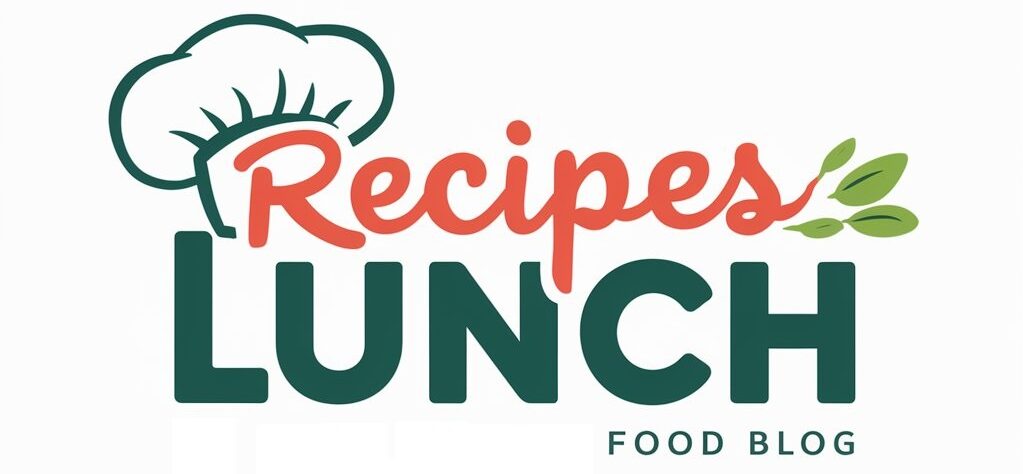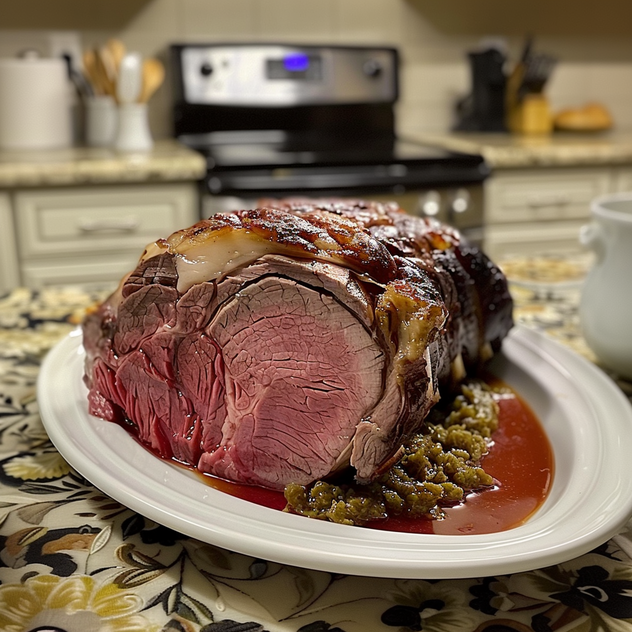Introduction
What is Prime Rib?
Prime rib, often heralded as the king of roasts, is a luxurious cut of beef that shines as the centerpiece of holiday feasts and special occasions. This tender, flavorful cut, derived from the primal rib section, boasts marbling that makes it incredibly juicy and rich in flavor. The prime rib’s appeal lies not just in its succulence but in its impressive presentation, making it a favorite for gatherings where you want to make a lasting impression.
Why This Guide?
Cooking prime rib to perfection requires more than just placing it in the oven. The right techniques are essential to ensure a juicy, flavorful roast that will have your guests raving. This guide covers every aspect of preparing prime rib, from selecting the right cut to serving it with the perfect accompaniments. Whether you’re a seasoned cook or a beginner, these steps will help you achieve a restaurant-quality roast at home.
Ingredients
Choosing the Prime Rib
- Bone-In vs. Boneless: When selecting your prime rib, you’ll need to decide between bone-in and boneless. Bone-in prime rib is often preferred for its superior flavor. The bones act as a natural roasting rack and contribute to the juiciness and richness of the meat. However, boneless cuts can be easier to carve and may cook slightly faster.
- Selecting the Grade: Prime rib can be purchased in different USDA grades—Prime, Choice, and Select. The grade reflects the amount of marbling, with Prime offering the highest level of intramuscular fat, resulting in the most tender and flavorful roast. Choice is a more affordable option that still provides excellent quality, while Select is leaner and may be less tender.
- How Much to Buy: When planning your meal, consider that one rib typically serves two to three people. For example, a three-rib roast will comfortably feed six to eight people. If you’re hosting a larger gathering, you may need a larger roast or multiple smaller ones.
Essential Seasonings
- Salt and Pepper: The foundational seasoning for prime rib is simply salt and pepper. A generous coating of kosher salt helps to draw out the meat’s natural flavors, while freshly ground black pepper adds a subtle spice that complements the richness of the beef.
- Herbs and Spices: Enhance your prime rib with aromatic herbs like rosemary and thyme, which pair beautifully with beef. Fresh garlic is another essential ingredient, adding depth and complexity to the flavor profile. You can also experiment with other herbs and spices, such as oregano, sage, or even a touch of cayenne for a bit of heat.
- Optional Ingredients: To elevate the flavor further, consider incorporating garlic butter, mustard rubs, or a horseradish crust. Garlic butter adds a rich, savory note that melts into the meat as it cooks, while mustard rubs introduce a tangy, slightly spicy kick. A horseradish crust provides a sharp contrast to the beef’s richness, creating a balanced and memorable dish.
Instructions Step by Step
Step 1: Preparing the Prime Rib
- Trimming: Begin by trimming any excess fat from the roast. While a layer of fat is desirable for flavor and moisture, too much can cause flare-ups in the oven and result in a greasy roast. Trim the fat cap down to about 1/4 inch for the best results.
- Tying the Roast: To ensure even cooking, it’s important to tie your roast with kitchen twine. Tying helps maintain the roast’s shape during cooking, preventing it from flattening out and cooking unevenly. This step is particularly crucial for bone-in roasts, as the bones can cause the meat to separate as it cooks.
- Bringing to Room Temperature: Before cooking, allow the prime rib to come to room temperature. This process, which takes about 2-3 hours, ensures more even cooking. A roast that goes straight from the refrigerator to the oven is more likely to cook unevenly, with the outer layers overcooking before the center reaches the desired temperature.
Step 2: Seasoning the Prime Rib
- Creating a Rub: In a small bowl, mix together your chosen herbs, spices, and aromatics. A classic rub might include a blend of kosher salt, freshly ground black pepper, minced garlic, chopped rosemary, and thyme. If you’re using mustard or horseradish, mix them with the other ingredients to create a paste.
- Applying the Rub: Rub the seasoning mixture all over the prime rib, making sure to coat all sides evenly. Press the rub into the meat to help the flavors penetrate. If possible, season the roast a day in advance and let it sit uncovered in the refrigerator. This dry brining process enhances the flavor and helps create a crisp, flavorful crust during cooking.
Step 3: Cooking Methods
- Traditional Roasting Method
- High Heat Sear, Slow Roast: Preheat your oven to 450°F (232°C) and place the prime rib on a rack in a roasting pan. Start by roasting at this high temperature for 15-20 minutes to develop a flavorful crust. Then, reduce the oven temperature to 325°F (163°C) and continue cooking until the internal temperature reaches your desired doneness. For rare, aim for 120°F (49°C); for medium-rare, 130°F (54°C); and for medium, 140°F (60°C).
- Benefits and Drawbacks: This method is straightforward and results in a beautifully browned exterior with a tender, juicy interior. However, it requires careful monitoring to avoid overcooking, especially with larger roasts.
- Reverse Sear Method
- Low and Slow, High Heat Finish: Begin by roasting the prime rib at a low temperature of 225°F (107°C) until the internal temperature is about 10°F (5°C) below your desired doneness. Then, remove the roast from the oven and increase the temperature to 500°F (260°C). Once the oven is hot, return the roast for a final sear, cooking for an additional 10-15 minutes until a crispy crust forms.
- Step-by-Step Instructions: This method offers greater control over the internal temperature, making it easier to achieve a consistent level of doneness throughout the roast. The reverse sear also minimizes the risk of overcooking and results in a juicier, more tender roast.
Step 4: Resting the Prime Rib
- Why Resting is Important: After cooking, it’s crucial to let the prime rib rest for at least 20-30 minutes before carving. Resting allows the juices, which are forced to the center of the roast during cooking, to redistribute throughout the meat. This process ensures that the meat remains moist and flavorful when sliced.
- How Long to Rest: The resting time can vary depending on the size of the roast, but a general rule of thumb is to rest the meat for about 15 minutes per pound. Cover the roast loosely with aluminum foil to keep it warm while it rests.
Step 5: Carving the Prime Rib
- Proper Techniques for Carving: When the roast has rested, it’s time to carve. Start by removing the kitchen twine and carefully separating the bones from the meat, if you’re using a bone-in roast. Slice the meat against the grain into thick slices for serving. Use a sharp carving knife and steady, even strokes to ensure clean, even slices that showcase the meat’s marbling.
Serving Suggestions
Classic Accompaniments
- Side Dishes: Prime rib pairs beautifully with a variety of classic side dishes. Garlic mashed potatoes and roasted vegetables like carrots, Brussels sprouts, and parsnips are traditional favorites. Yorkshire pudding, with its light and airy texture, is another popular choice. For a touch of indulgence, creamed spinach offers a rich, velvety complement to the robust flavors of the prime rib.
- Sauces: The right sauce can elevate your prime rib to new heights. Horseradish sauce, with its sharp, tangy flavor, cuts through the richness of the beef. Au jus, a light gravy made from the roast’s drippings, enhances the meat’s natural flavors. For a more sophisticated option, consider a red wine reduction, which adds depth and complexity to the dish.
Wine Pairings
- Red Wines: The richness of prime rib calls for a full-bodied red wine. Cabernet Sauvignon is a classic pairing, offering bold flavors and tannins that stand up to the meat’s intensity. Merlot, with its softer tannins and fruit-forward profile, is another excellent choice. If you prefer something a bit different, a Syrah or Malbec can provide a more robust, peppery complement to the prime rib.
Garnishing the Plate
- Ideas for Garnishes: For a polished presentation, consider garnishing your prime rib with fresh herbs like rosemary or thyme. Roasted garlic cloves or caramelized onions add both flavor and visual appeal. For a touch of color, scatter some pomegranate seeds or cranberries around the plate, or add a sprig of parsley for a simple, elegant finish.
FAQs
- What’s the Difference Between Prime Rib and Ribeye?
- Prime rib and ribeye both come from the rib section of the cow, but they differ in preparation and presentation. Prime rib is a large roast that includes several ribs, while ribeye is a steak cut from the same section, typically boneless and cooked individually.
- Can I Cook Prime Rib from Frozen?
- While it’s possible to cook prime rib from frozen, it’s not recommended.

